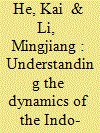|
|
|
Sort Order |
|
|
|
Items / Page
|
|
|
|
|
|
|
| Srl | Item |
| 1 |
ID:
189245


|
|
|
|
|
| Summary/Abstract |
This article examines the new prominence accorded to the “Indo-Pacific” (IP) concept in the strategic narratives championed by the US and its closest allies, (Japan and Australia), and then juxtaposes this with the responses of other key regional powers. To this purpose, Part I distils a concise conceptual model encompassing three interlocking facets – mental maps, political/ideological drivers, and visions of regional order – designed to structure the following empirical analyses. Part II then accesses this model to reveal how these facets are reflected in the discursive and policy-making practices of the US and its close allies, as embodied in their (combined) regional strategies. Next, Part III considers how a cross-section of major states in the region – India, South Korea, and China - have responded to this enterprise, to determine the degree to which they have adopted, accommodated or opposed the IP concept, or otherwise propose national alternatives to the US-centered project. It concludes that the IP concept is not simply an objective geopolitical descriptor, but rather a controversial and contested discursive field, subject to multiple interpretations. Such a polarizing concept will likely contribute to further sharpening of strategic mistrust and geopolitical competition amongst the region’s major powers.
|
|
|
|
|
|
|
|
|
|
|
|
|
|
|
|
| 2 |
ID:
176235


|
|
|
|
|
| Summary/Abstract |
As a geographical concept, ‘Indo-Pacific’ has existed for decades. As a political and strategic concept, it has since 2010 gradually become established in the foreign policy lexicon of some countries, especially Australia, India, Japan and the United States. However, China seems to be reluctant to identify itself as part of the Indo-Pacific; Chinese leaders believe that the US-led Indo-Pacific strategy aims to contain China's rise. While the battle between the two geographical concepts ‘Indo-Pacific’ and ‘Asia–Pacific’ may be fairly easily settled in the future, US–China strategic competition has just begun. Will the Indo-Pacific become a battlefield for US–China rivalry? How will China cope with the US ‘free and open Indo-Pacific’ (FOIP) strategy? How will other regional actors respond to the US–China strategic competition in the Indo-Pacific? What are the strategic implications of the ‘Indo-Pacific’ concept for regional order transformation? How will the Indo-Pacific be institutionalized, economically, politically and strategically? This article introduces the January 2020 special issue of International Affairs, which aims to address those questions, using both country-specific and regional perspectives. Seven articles focus on the policy responses of major players (Australia, China, India, Indonesia, Japan and ASEAN) to the US FOIP strategy and related US–China rivalry in the region. A further three articles examine the profound implications of Indo-Pacific dynamics for regional institution-building and for geopolitical and geo-economic architecture.
|
|
|
|
|
|
|
|
|
|
|
|
|
|
|
|
|
|
|
|
|